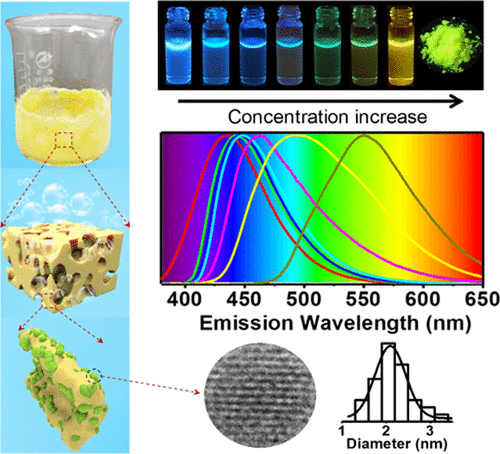当前位置:
X-MOL 学术
›
ACS Appl. Mater. Interfaces
›
论文详情
Our official English website, www.x-mol.net, welcomes your
feedback! (Note: you will need to create a separate account there.)
Solid-State Fluorescent Carbon Dots with Aggregation-Induced Yellow Emission for White Light-Emitting Diodes with High Luminous Efficiencies
ACS Applied Materials & Interfaces ( IF 8.3 ) Pub Date : 2019-06-18 00:00:00 , DOI: 10.1021/acsami.9b04600 Yongqiang Zhang 1, 2 , Peng Zhuo 1, 2 , Hao Yin 1, 2 , Yi Fan 3 , Jiahua Zhang 3 , Xingyuan Liu 3 , Zhenqiang Chen 1, 2
ACS Applied Materials & Interfaces ( IF 8.3 ) Pub Date : 2019-06-18 00:00:00 , DOI: 10.1021/acsami.9b04600 Yongqiang Zhang 1, 2 , Peng Zhuo 1, 2 , Hao Yin 1, 2 , Yi Fan 3 , Jiahua Zhang 3 , Xingyuan Liu 3 , Zhenqiang Chen 1, 2
Affiliation

|
For practical applications of carbon dots (CDs), a major challenge is to prevent the notorious aggregation-caused quenching (ACQ) effect. Herein, a new type of CDs (CD1) has been developed that can transform from ACQ to an enhancement of fluorescence by aggregation-induced emission (AIE). The blue fluorescence of the CDs is suppressed by ACQ. However, this is accompanied by the phenomenon of AIE at a longer wavelength, resulting in the emergence and gradual enhancement of yellow fluorescence. The obtained CD1 solid powder shows a bright yellow emission with a photoluminescence quantum yield (PLQY) of 65%. The photoluminescence (PL) spectra, absorption spectra, and time-resolved PL decay curves indicate that Förster resonant energy transfer from dispersed CD1 particles to large CD1 agglomerations leads to the enhancement of yellow fluorescence. To exploit its high PLQY and strong AIE, CD1 is applied as a color-converting layer on blue light-emitting diode (LED) chips to fabricate white LEDs (WLEDs). The obtained devices show white light coordinates of (0.29, 0.38) and (0.32, 0.42), which are close to pure white light (0.33, 0.33), and luminous efficiencies of 97.8 and 93.9 lm·W–1 and show good stability. The low cost, easy fabrication, controllability, and favorable fluorescence properties signify that CD1 of AIE will have superior performance in a variety of applications.
中文翻译:

具有高发光效率的白光发光二极管的聚集诱导黄光固态荧光碳点。
对于碳点(CD)的实际应用,主要挑战是防止臭名昭著的聚集引起的猝灭(ACQ)效应。在本文中,已经开发了一种新型的CD(CD1),可以通过聚集诱导发射(AIE)从ACQ转变为增强荧光。CD的蓝色荧光被ACQ抑制。然而,这伴随着较长波长的AIE现象,导致黄色荧光的出现并逐渐增强。所获得的CD1固体粉末显示出亮黄色发射,其光致发光量子产率(PLQY)为65%。光致发光(PL)光谱,吸收光谱和时间分辨的PL衰减曲线表明,从分散的CD1颗粒到大的CD1团聚体的Förster共振能量转移导致黄色荧光的增强。为了利用其高PLQY和强AIE,将CD1用作蓝色发光二极管(LED)芯片上的色彩转换层,以制造白色LED(WLED)。获得的器件显示的白光坐标为(0.29,0.38)和(0.32,0.42),接近纯白光(0.33,0.33),发光效率为97.8和93.9 lm·W–1并显示出良好的稳定性。低成本,易于制造,可控制性和良好的荧光特性表明AIE的CD1在各种应用中将具有出色的性能。
更新日期:2019-06-18
中文翻译:

具有高发光效率的白光发光二极管的聚集诱导黄光固态荧光碳点。
对于碳点(CD)的实际应用,主要挑战是防止臭名昭著的聚集引起的猝灭(ACQ)效应。在本文中,已经开发了一种新型的CD(CD1),可以通过聚集诱导发射(AIE)从ACQ转变为增强荧光。CD的蓝色荧光被ACQ抑制。然而,这伴随着较长波长的AIE现象,导致黄色荧光的出现并逐渐增强。所获得的CD1固体粉末显示出亮黄色发射,其光致发光量子产率(PLQY)为65%。光致发光(PL)光谱,吸收光谱和时间分辨的PL衰减曲线表明,从分散的CD1颗粒到大的CD1团聚体的Förster共振能量转移导致黄色荧光的增强。为了利用其高PLQY和强AIE,将CD1用作蓝色发光二极管(LED)芯片上的色彩转换层,以制造白色LED(WLED)。获得的器件显示的白光坐标为(0.29,0.38)和(0.32,0.42),接近纯白光(0.33,0.33),发光效率为97.8和93.9 lm·W–1并显示出良好的稳定性。低成本,易于制造,可控制性和良好的荧光特性表明AIE的CD1在各种应用中将具有出色的性能。































 京公网安备 11010802027423号
京公网安备 11010802027423号